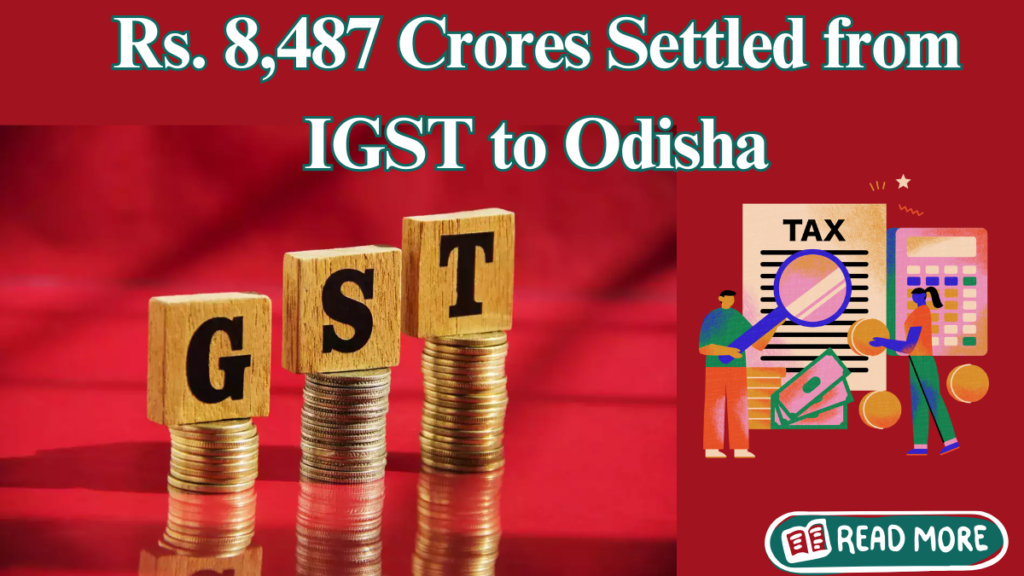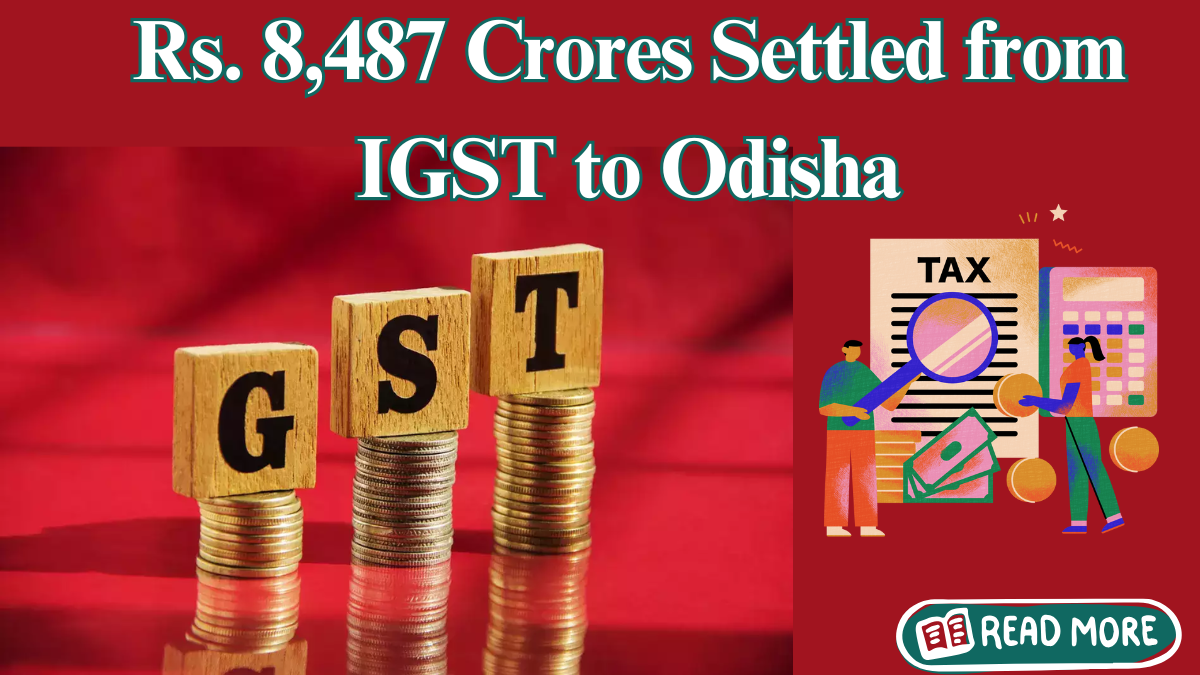In a significant move, the Minister of State in the Ministry of Finance, Shiri Pankaj Chaudhary, recently confirmed that the state of Odisha has received Rs. 8,487 Crores from the Integrated Goods and Services Tax (IGST) portion for the financial year 2023-24. This statement was made in a written reply to a question raised in the Lok Sabha, underscoring the role of IGST in supporting the state’s economic development and public services.
The settlement of Rs. 8,487 Crores marks an important financial boost for the state, ensuring a stable revenue stream, which is crucial for addressing the state’s infrastructural needs and providing essential services to its citizens.

What is IGST and Why Is It Important?
Integrated Goods and Services Tax (IGST) is a key component of the Goods and Services Tax (GST) framework that was introduced in India on 1st July 2017. IGST is specifically designed for inter-state transactions of goods and services, enabling the collection of taxes when goods and services are transferred between states. Unlike the Central GST (CGST) and State GST (SGST), which apply within a particular state, IGST is applied to transactions involving multiple states.
The IGST mechanism ensures that the entire country benefits from a seamless and uniform tax system, making it easier for businesses to operate across state boundaries. It also helps the central government collect taxes, which are then distributed among states, maintaining a balance and fairness in revenue distribution.
Odisha’s Revenue from IGST
For the financial year 2023-24, the state of Odisha has received a total settlement of Rs. 8,487 Crores from the IGST pool. This settlement is part of the larger pool of revenue collected under GST, which is shared between the central government and individual states.
The state of Odisha, like all states, depends on IGST settlements to finance various projects, welfare programs, and infrastructural developments. The transfer of Rs. 8,487 Crores is not only essential for the state’s fiscal health but also plays a vital role in ensuring that the state can continue to provide services such as healthcare, education, and infrastructure development. This financial injection contributes significantly to the state’s economic well-being.
How Is the IGST Revenue Distributed?
Under the GST system, the tax collected on goods and services is divided into CGST and SGST when transactions occur within a state. However, when goods and services are transferred between states, IGST is levied, and the proceeds are shared between the central government and the respective states.
Each state’s share is determined based on various factors such as the state’s economic activity, population, and other criteria set by the GST Council. In the case of Odisha, the Rs. 8,487 Crores received from IGST reflects the state’s share in the overall revenue pool based on these factors.
The Role of IGST in Odisha’s Economy
The settlement of Rs. 8,487 Crores plays a crucial role in the state’s fiscal planning and budgeting. These funds are used to finance a wide range of activities, from developing infrastructure to funding social welfare schemes. For instance, Odisha has been making significant progress in road construction, healthcare, and education, with funds such as these supporting those initiatives.
Moreover, IGST funds enable the state government to implement policies that stimulate economic growth, such as promoting industrial growth and attracting investment. This ensures the long-term economic stability of the state, benefiting both businesses and residents.
Challenges in GST Revenue Distribution
While the settlement of Rs. 8,487 Crores is a welcome development, the process of revenue distribution under the GST system is not without its challenges. The Group of Ministers (GoM), as mentioned in the Minister’s reply, is tasked with analyzing state-wise revenue trends. This group aims to examine the challenges that states face regarding revenue collection and distribution under the GST framework.
Several factors, including economic slowdowns, changes in consumption patterns, and global trade disruptions, can impact the flow of revenue from GST. States like Odisha, which are heavily reliant on certain industries, may experience fluctuations in revenue based on external factors.
To address these issues, the GoM has been given the responsibility to recommend policies to enhance revenue collection and mitigate any adverse economic impacts. By suggesting reforms and monitoring the implementation of these policies, the GoM helps ensure that the GST system remains robust and effective for all states, including Odisha.
Odisha’s Future Prospects with IGST Settlements
With the settlement of Rs. 8,487 Crores, Odisha is in a strong position to plan and execute developmental projects for its citizens. These funds are expected to bolster sectors such as healthcare, education, urban development, and infrastructure.
In the coming years, the state’s economy is expected to grow further, driven by investments in key sectors such as mining, manufacturing, agriculture, and tourism. The stability provided by IGST settlements ensures that Odisha can capitalize on this growth by investing in long-term projects and improving the standard of living for its residents.
Conclusion
The settlement of Rs. 8,487 Crores from the IGST pool to the state of Odisha underscores the importance of the GST system in ensuring equitable revenue distribution among states. This settlement helps strengthen Odisha’s fiscal health, enabling the state government to invest in critical development projects and welfare schemes.
With the Group of Ministers (GoM) working to address any challenges in the system, Odisha can look forward to a more efficient and effective revenue-sharing mechanism in the future. The IGST system continues to play a pivotal role in the economic development of states across India, with Odisha benefiting significantly from this well-structured tax system.
FAQs
Q1: What is IGST, and how does it benefit states like Odisha?
A1: IGST, or Integrated Goods and Services Tax, is a tax levied on inter-state transactions. It benefits states like Odisha by providing a significant share of the revenue collected on goods and services that are transferred across state boundaries, helping fund development projects and welfare programs.
Q2: How is IGST revenue distributed among states?
A2: IGST revenue is shared between the central government and states, with each state receiving a portion based on factors such as economic activity and population.
Q3: What challenges does Odisha face in GST revenue collection?
A3: Odisha, like other states, may face challenges in revenue collection due to factors like economic slowdowns and changes in trade patterns. These challenges are being addressed by the Group of Ministers (GoM).
Q4: How does the Group of Ministers (GoM) support Odisha’s GST revenue?
A4: The GoM analyzes state-wise revenue trends and recommends policies to enhance revenue collection and mitigate any negative impacts on GST revenue.
Q5: What is the role of IGST in Odisha’s economic development?
A5: IGST revenue helps Odisha invest in infrastructure, healthcare, education, and other public services, contributing to the state’s long-term economic growth.
Click here to learn more.
Pari is a passionate writer known for captivating stories that blend imagination and reality. Inspired by travel, history, and everyday moments, Pari crafts narratives that resonate deeply with readers.




